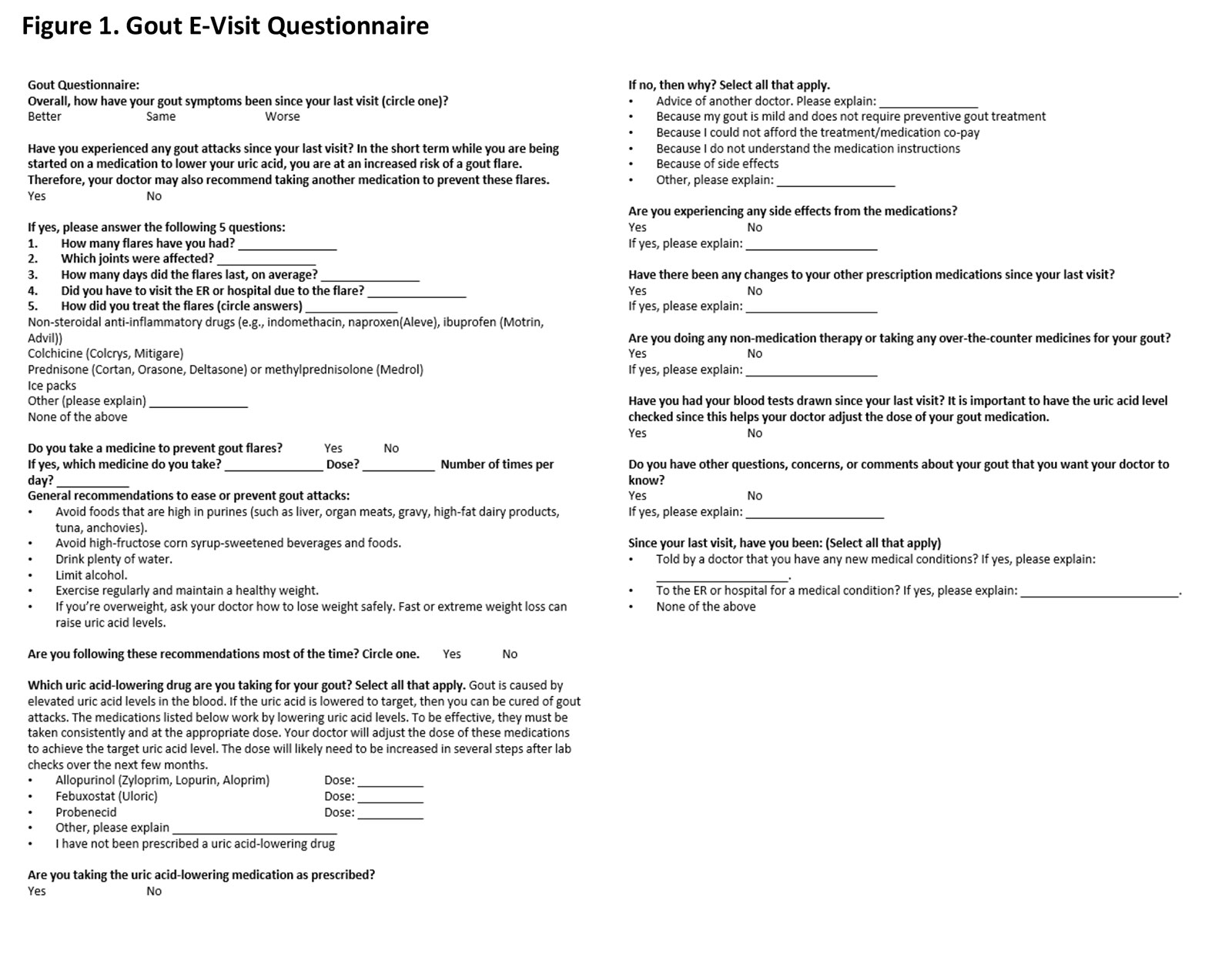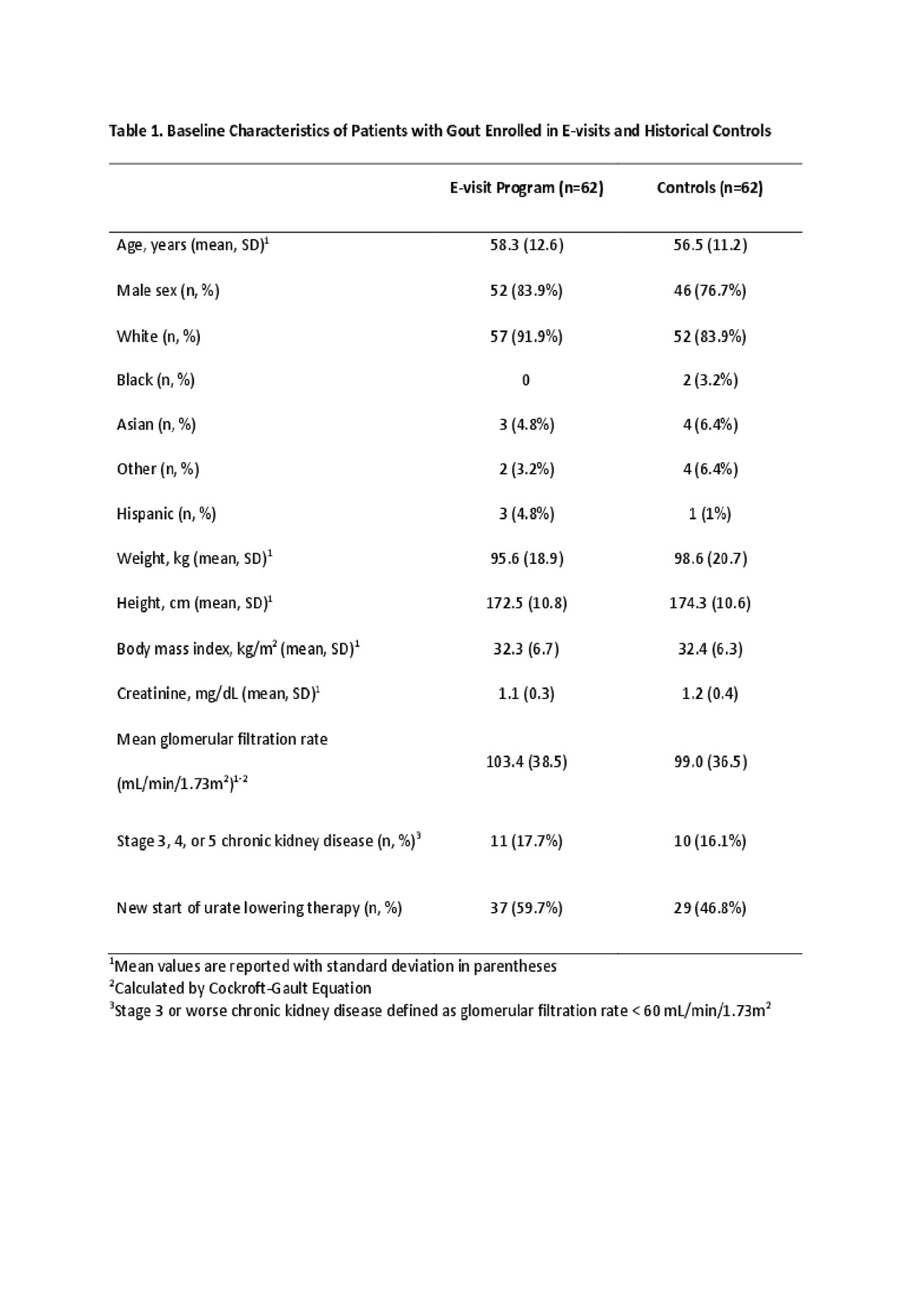Session Information
Session Type: ACR Abstract Session
Session Time: 4:30PM-6:00PM
Background/Purpose: Gout is a highly prevalent form of inflammatory arthritis associated with increased morbidity and mortality, and the burden of gout on the healthcare system has continued to climb despite the widespread availability of effective medications. The American College of Rheumatology management guidelines for gout recommend a “treat-to-target” approach with a goal serum urate (SU) level < 6 mg/dL in most patients with gout with the use of urate-lowering therapy (ULT) such as allopurinol. However, achieving goal SU levels in patients with gout remains difficult in primary care and rheumatology practices. We hypothesized that an asynchronous electronic visit (E-visit) program could facilitate achieving a goal SU < 6 mg/dL among patients with gout on ULT.
Methods: Patients with rheumatologist-diagnosed gout and SU levels greater than 6 mg/dL either starting or continuing titration of ULT were eligible for the study and were enrolled in the E-visit program at the treating physicians’ discretion between April 1, 2017 and May 31, 2018. The E-visit program consisted of an electronic questionnaire (Figure 1) that assessed medication compliance and recent symptoms and provided educational information on gout triggers and the “treat-to-target” approach for gout management. The E-visit also served as a reminder to the patient to have laboratory testing performed, as recommended by his/her physician. Once the E-visit was completed by the patient, the treating physician was notified to review the patient’s responses (thus asynchronous) and recommend further action (including adjustment of ULT dose). We performed a retrospective cohort study, comparing patients who enrolled in the E-visit program with age- and sex-matched historical controls who received usual care and were seen within 12 months prior to E-visit program initiation. The primary outcome of interest was the proportion of patients achieving target SU level < 6 mg/dL at 6 months.
Results: Sixty-two patients were enrolled in the gout asynchronous E-visit program and were compared to 62 historical controls. Baseline characteristics including age, sex, body mass index, renal function, and initial SU were similar among patients enrolled in the E-visit program and controls (Table 1). At six months, E-visit patients had a lower mean SU level than the historical controls (5.5 mg/dL vs. 6.6 mg/dL, respectively, p < 0.01) (Table 2). The number of patients achieving a goal SU of < 6 mg/dL at the end of 6 months was higher in the E-visit group compared to control patients (61.3% vs. 29.0%, respectively, p < 0.01) (Table 2).
Conclusion: In this pilot study, a physician-initiated E-visit program led to a substantial improvement in the proportion of patients achieving goal SU in an academic rheumatology practice. E-visits may be a useful tool to improve gout management and achieve SU goals. Further studies should assess the generalizability and cost-effectiveness of an E-visit program in both academic and community rheumatology practice settings.

ACR 2019 Gout QI Abstract Figure 1

ACR 2019 Gout QI Abstract Table 1

ACR 2019 Gout QI Abstract Table 2
To cite this abstract in AMA style:
Yokose C, Jorge A, D'Silva K, Serling-Boyd N, Matza M, Nasrallah M, Keller S, Oza A, Choi H, Bolster M, Collier D. Using Electronic Visits (E-Visits) to Achieve Goal Serum Urate Levels in Patients with Gout in a Rheumatology Practice: A Pilot Study [abstract]. Arthritis Rheumatol. 2019; 71 (suppl 10). https://acrabstracts.org/abstract/using-electronic-visits-e-visits-to-achieve-goal-serum-urate-levels-in-patients-with-gout-in-a-rheumatology-practice-a-pilot-study/. Accessed .« Back to 2019 ACR/ARP Annual Meeting
ACR Meeting Abstracts - https://acrabstracts.org/abstract/using-electronic-visits-e-visits-to-achieve-goal-serum-urate-levels-in-patients-with-gout-in-a-rheumatology-practice-a-pilot-study/
